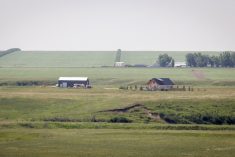Aside from concerns regarding drier conditions in different potato-growing regions of Ontario, some growers are testing for late blight. Spore traps near Delhi came back negative recently — but did indicate an increase at the end of the experiment.
Eugenia Banks, a consultant for the Ontario Potato Board, stated such a “signal” might indicate an increase in the population of the fungus that causes late blight, even though it’s under the detection limit.
“A spray is recommended for the Simcoe-Delhi area where early planted fields are flowering or are close to flowering,” Banks said in a brief summary from Friday.
Read Also

Alberta crops 21 points below average but soil moisture improving
Prior to Alberta getting rain over the weekend of June 21 and 22, the province’s crops were well below the five-year average for ratings. As of June 17, Alberta Agriculture said they were listed as 50 per cent good to excellent overall compared to the average of 71 per cent.
Late blight test results from the Shelburne and Alliston areas were negative at the start and finish of last week, she added, noting early spraying against late blight always pays off.
In the Alliston region, many fields are expected to be at row closure within the next few days. At the same time, prior to last Friday, there’d been sufficient rainfall to create conditions that are perfect for late blight. Added to that, this past weekend saw several storm cells in the area, with more-than-enough rainfall in both the Alliston fields and those in the Shelburne area.
The heavier rainfall around Shelburne should help those fields that were recently planted, Banks said. Simcoe-Delhi, on the other hand, missed out on the weekend rain events.
Other disease updates
There have been reports concerning blackleg — including a new strain — and brown spot in different regions.
According to Banks, blackleg was reported in an early-planted field of potatoes grown for the fresh market. Its spread can be reduced by copper hydroxide application.
The lack of precipitation in the Simcoe-Delhi region has also spurred the development of brown spot, a problem that emerges in dry weather conditions.
Of particular concern is the announcement of Dickeya, found in Wisconsin. Although it’s a new strain of blackleg, it exhibits typical symptoms, including wilted plants with black rotting stem bases. An application of copper can reduce the spread when wet weather is an ongoing issue.
New varieties
Banks also details her experiences with Spartan Chipper (from Michigan State University) and AAC Glossy (from Agriculture and Agri-Food Canada). She planted the varieties in plots on May 7 near Alliston.
Spartan Chipper emerged quickly, with vigorous plant growth and a maturity that’s slightly behind Dakota Pearl, which is already in flower. Spartan Chipper can be chipped right out of the field but may also be a candidate for lengthier storage.
Glossy is another fast-emerging plant and appears to be similar to Envol in terms of maturity. It’s marketed by La Patate Lac St. Jean with a cream-coloured flesh, and is grown for the fresh market.
— Ralph Pearce is a field editor for Country Guide at St. Marys, Ont. Follow him at @arpee_AG on Twitter.















